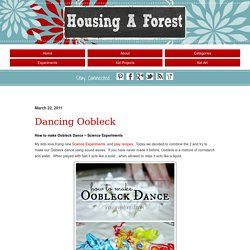

Homeschool Botany Activities and Games Free Downloads. Make a Bouncing Polymer Ball - Experiment with Polymers. Introduction Balls have been toys practically forever, but the bouncing ball is a more recent innovation.

Bouncing balls were originally made of natural rubber, though now bouncing balls can be made of plastics and other polymers or even treated leather. You can use chemistry to make your own bouncing ball. Once you understand the basic technique, you can alter the recipe for the ball to see how the chemical composition affects the bounciness of the ball, as well as other characteristics. The bouncing ball in this activity is made from a polymer. Make Your Own Rock Candy.
A wooden skewer (you can also use a clean wooden chopstick) A clothespin 1 cup of water2-3 cups of sugarA tall narrow glass or jar Clip the wooden skewer into the clothespin so that it hangs down inside the glass and is about 1 inch (2.5 cm) from the bottom of the glass.

(as shown) Remove the skewer and clothespin and put them aside for now. Get a helpful adult! Pour the water into a pan and bring it to boil. Pour about 1/4 cup of sugar into the boiling water, stirring until it dissolves. Want colored rock candy? When you mixed the water and sugar you made a SUPER SATURATED SOLUTION. Dancing Oobleck. My kids love trying new Science Experiments, and play recipes.

Today we decided to combine the 2 and try to make our Oobleck dance using sound waves. If you have never made it before, Oobleck is a mixture of cornstarch and water. When played with fast it acts like a solid…when allowed to relax it acts like a liquid. This post contains affiliate links for your convenience. When we saw a few youtube videos that involved Dancing Oobleck, we decided we needed to take our gooey play to the next level.
Dancing Oobleck Recipe You will need to make your Oobleck thicker than usual. About 2 cups of Corn Starch to 1 cup of water. Materials Needed: Once your recipe is ready let the kids play for a bit while you set up the next step. Instructions: Place the cookie sheet onto the speaker of the sub, and pour in the Oobleck.You can download different test tones and play to see what works best for you. Mad Professor. Science for Kids - Fun Experiments, Cool Facts, Online Games, Activities, Projects, Ideas, Technology. Social skills activities for children and teenagers. Social skills activities for children and teens: Evidence-based ideas to help kids communicate, connect, empathize, and read minds © 2015 Gwen Dewar, Ph.D., all rights reserved Social skills activities put to the test We want our children to succeed in the social world--to learn how to cooperate, make friends, and negotiate conflicts.

We want them to develop strong perspective-taking skills, and treat other people with fairness and compassion. How can we help them do it? For instance, middle school children (11-14 years old) experienced significant changes after playing Awkward Moment™, a researcher-designed party game that requires players to choose solutions to thorny social problems. Other studies indicate that friendly, "prosocial" video games -- like Mario Sunshine™ or Animal Crossing™ -- motivate players to be more kind, sympathetic, and helpful. So here they are: Research-inspired social skills activities, listed by age group. Social skills activities for toddlers Taking turns Charades.
Test Your Dominant Side - Eye, Hand & Foot. What you'll need: A pen or pencil Paper or a notepad to write your findings on An empty tube (an old paper towel tube is good) A cup of water A small ball (or something soft you can throw) Instructions: Write ‘left’ or ‘right’ next to each task depending on what side you used/favored.

When you’ve finished all the challenges review your results and make your own conclusions about which is your dominant eye, hand and foot. Eye tests: Which eye do you use to wink? Hand/Arm tests: Which hand do you use to write? Foot/Leg tests: Run forward and jump off one leg, which did you jump off? What's happening? So what side do you favor? Around 90% of the world’s population is right handed. Others think the reason might have more to do with culture. Around 80% of people are right footed and 70% favor their right eye.
Try testing others and coming to your on conclusions about what side the human body favors and why. Extra: Are you more likely to be left handed if one of your parents is left handed?